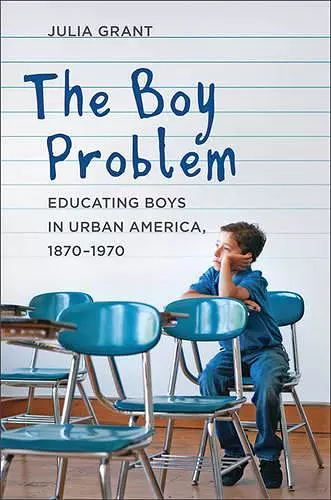The Boy Problem
Educating Boys in Urban America, 1870–1970
Format:Hardback
Publisher:Johns Hopkins University Press
Published:11th Apr '14
Currently unavailable, and unfortunately no date known when it will be back

What's the problem with boys? As Julia Grant demonstrates, the question has been with us for more than a century. Tracing our answers over time, Grant provides the first truly historical portrait of masculinity and education in the United States. Her book is imaginatively conceived, painstakingly researched, and clearly written. It will be cited, read, and adopted by scholars of education, history, and gender for many years to come. -- Jonathan Zimmerman, author of Small Wonder: The Little Red Schoolhouse in History and Memory
Grant's cogent analysis will interest education policy-makers and educators, as well as scholars of the history of education, childhood, gender studies, American studies, and urban history.America's educational system has a problem with boys, and it's nothing new. The question of what to do with boys - the "boy problem" - has vexed educators and social commentators for more than a century. Contemporary debates about poor academic performance of boys, especially those of color, point to a myriad of reasons: inadequate and punitive schools, broken families, poverty, and cultural conflicts. Julia Grant offers a historical perspective on these debates and reveals that it is a perennial issue in American schooling that says much about gender and education today. Since the birth of compulsory schooling, educators have contended with what exactly to do with boys of immigrant, poor, minority backgrounds. Initially, public schools developed vocational education and organized athletics and technical schools as well as evening and summer continuation schools in response to the concern that the American culture of masculinity devalued academic success in school. Urban educators sought ways to deal with the "bad boys" - almost exclusively poor, immigrant, or migrant - who skipped school, exhibited behavioral problems when they attended, and sometimes landed in special education classes and reformatory institutions. The problems these boys posed led to accommodations in public education and juvenile justice system. This historical study sheds light on contemporary concerns over the academic performance of boys of color who now flounder in school or languish in the juvenile justice system. Grant's cogent analysis will interest education policy-makers and educators, as well as scholars of the history of education, childhood, gender studies, American studies, and urban history.
Grant is a superb historian who does more than just chronicle events; she also sketches their context and thus their significance. Choice Grant's study is successful for its engaging prose and ability to reach across a broad variety of fields, including education, juvenile justice, and childhood, youth, and gender studies, to delineate the interlocking histories of institutions of social control for young people and reveal the deeply entrenched ideologies of gender, class, ethnicity, and race that shaped their establishment and development in the nineteenth and twentieth centuries. -- Miroslava Chavez-Garcia American Historical Review This short book provides a much-needed historical perspective on a question that has generated a lot of debate: why do boys so often perform poorly academically and act disruptively at school?... The Boy Problem is a valuable historical study of a pressing social problem that will find wide readership in social work, childhood studies, and education. -- Molly Ladd-Taylor Historical Studies in Education [Grant] makes an original contribution by keeping her eye on the prize: understanding the many ways in which gender shaped the world and life chances of lower class boys since the nineteenth century. That is a major accomplishment in this succintly written history. Journal of the History of Childhood and Youth
ISBN: 9781421412597
Dimensions: 229mm x 152mm x 21mm
Weight: 454g
240 pages